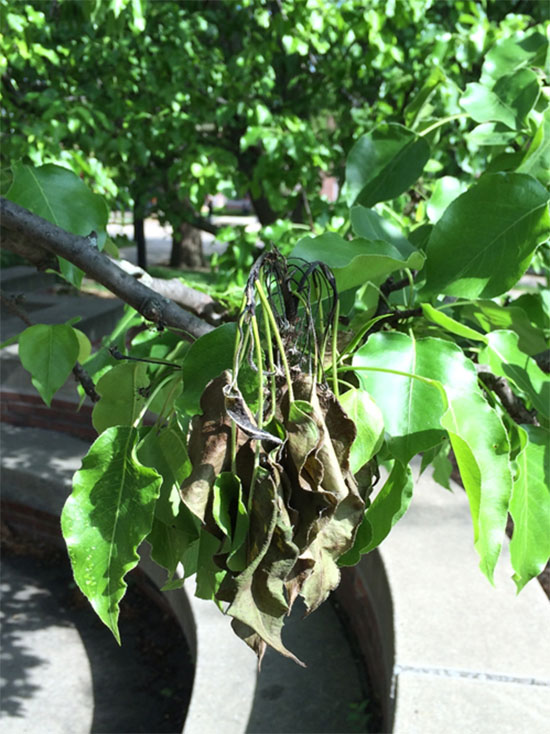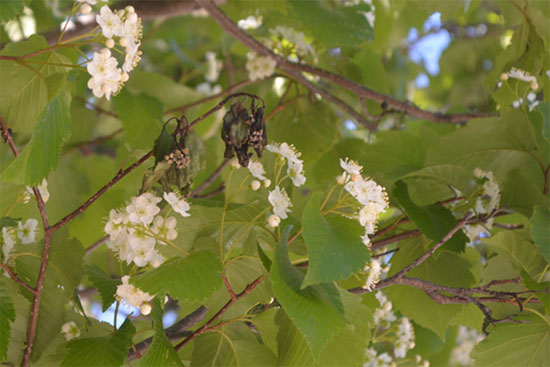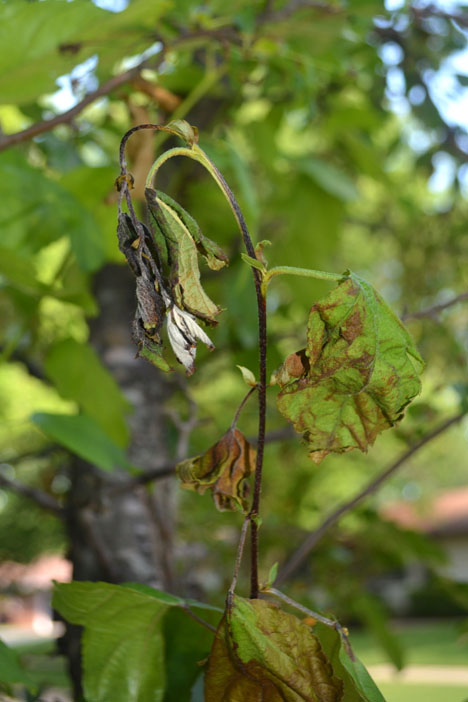Issue 3, May 11, 2015
Fire Blight
Fire Blight symptoms started to appear on several rosaceous hosts this past week. The majority of the foliage on the trees that I observed appeared healthy, with only a few branch ends affected by the disease. Warm temperatures followed by moist conditions that occurred during flowering lead me to suspect that more branches will likely be affected as we progress through the month of May.
Fire blight is a bacterial disease that affects rosaceous plants. Apples, pears, crabapples, and ornamental pears are the most seriously affected species. Other rosaceous hosts include: cotoneaster, hawthorn, quince, firethorn, and mountain-ash.
Affected trees have water-soaked or wilted new growth at the branch tip that quickly turns brown to black and remains attached to the stem (Photo 1 & Photo 2). Frequently, the tip of the blighted shoot bends over and forms a distinctive diagnostic feature that resembles a shepherd's crook (Photo 3). Symptoms are similar to frost injury. Cankers also develop in the wood of infected stems and branches (Photo 4).

Blighted leaves on Callery pear infected with Fire Blight

Blighted leaves on Korean mountainash infected with Fire Blight

Shepherd's crook Fire Blight symptom on crabapple.

Fire blight canker on the branch of a Callery pear.
Fire blight is caused by a bacterium (Erwinia amylovora). The pathogen overwinters in living tissue at the margins of trunk and branch cankers that were formed by infections initiated in previous years. The disease can cause numerous cankers on a single tree. Not all cankers survive the winter, but the few that persist produce millions of bacteria capable of causing new infections. Rain or insects move the bacterium from cankers to open blossoms, vigorous shoot tips, and leaves. Fire Blight outbreaks sometimes occur following severe storms. Gusty winds and hail wound the trees, creating an entry point for the pathogen. The bulk of the infections occur during flowering when temperatures are warm (optimal 76°F) and conditions are wet. These conditions also encourage rapid disease development.
An important step to controlling this fire blight is avoiding highly susceptible cultivars. Prior to planting new trees, research and select plants and cultivars known to have good to excellent fire blight resistance. When selecting crabapples, also consider other common diseases such as apple scab and cedar rusts. There is no effective management option for trees infected with fire blight. Prune out infected wood in the dormant season, if you can wait. If not, prune in an extended dry period and disinfect pruning tools after every cut. The bacterium may have extended down the stem ahead of the canker. Unfortunately this means wood should be removed 8-10 inches below the edge of the visible canker. Chemical options are limited, especially for homeowners and the timing of sprays are also critical. Commercial growers apply copper products in the dormant season and streptomycin at 4-5 day intervals throughout bloom. Fertilization and watering are not recommended. Such practices will promote lush growth, which is more susceptible to infection by the fire blight bacterium. (Travis Cleveland)
Author:
Travis Cleveland